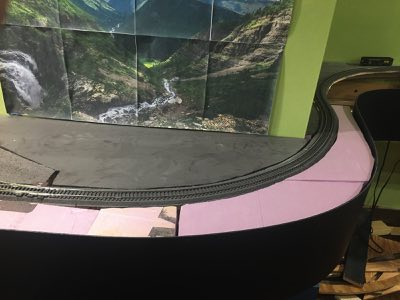 |
|
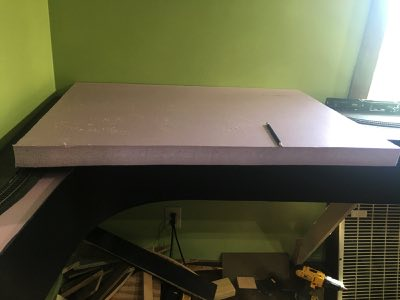 |
| Even though the
governor's "stay at home" coronavirus order has shut down our
weekly train night sessions work still continues with a skeleton
crew. John cuts four pieces of foam board leading into the
dreaded "S" curve. |
Dragging out a new
4'x8' sheet of foam board the CFO marks off a 26"x36" square to
cover the remaining portion of the S curve as well as the north
Usibelli Coal Mine switch. |
This foam board is
put in place and the measurements are checked again. Both Max
and Indy spent their time getting in the way of the crew. |
 |
|
|
| Using a pencil the
CFO traces the fascia board and road bed lines. The L-girder
braces make this a very challenging effort. |
The weather is
drop dead awesome so working outside is a joy. Terry and John
move the foam board square to the balcony and use the jigsaw to
make the necessary cuts. |
After a few fine
tuning cuts the foam board fits like a glove! The only remaining
foam board installation is the Flint Hills Refinery switch and
the mountain. Yeah! |
|
|
 |
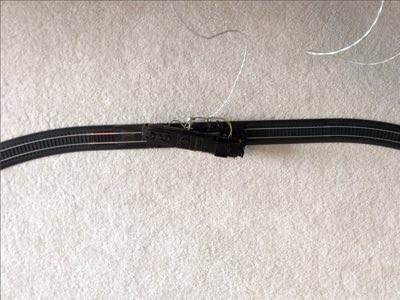 |
|
Several of the locomotives are acting finicky.
Using gloves (coronavirus contamination prevention) John picks
out three locomotives, some snap track and a power pack. He
drops them off on Rick's front porch so he can do some trouble
shooting. It is important to first test to see if the
locomotives work correctly under DC power operations.
Rick says of his photo, "This is a harness I
built to test the locomotives. It allows access to four lines:
orange (motor +), gray (motor -), red (power +), black (power
-)."
|
"No. 2503
connected to power cable. Power is connected where power comes
from the trucks, thus using wiring of the loco. The test harness
is installed with orange to red, gray to black. This is a DC
mode test. Test passed. Two loops around the track." |
"Video of DC mode test. Number 2503 passed.
"Also connected to 2503 was power from the Tech
II Railmaster power supply. In both videos you can see the white
wires running from the Tech II to 2503. The track was not
powered. The DC test required the orange wire to be connected to
the red wire and the gray wire connected to the black wire. Test
ran successfully. The decoder test required the decoder to be
connected to the test harness with the orange to red and gray to
black connections removed. In the first video you can see the
clip leads used for orange to red and gray to black connections.
"
|
|
|
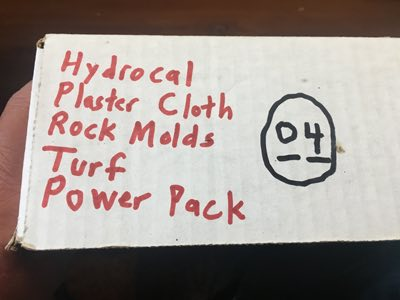 |
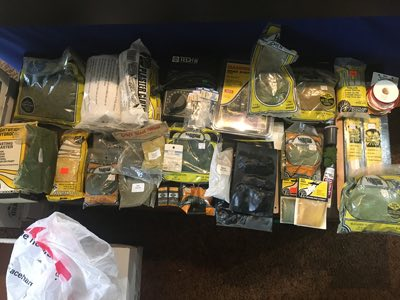 |
|
"Number 2503 decoder test. Test passed.
"This video shows the decoder running the loco.
The handheld simulator on my laptop was used for this test. All
loco functions worked (horn, bell, lights). 2503 made two loops
around the track with no issues.
"No. 1500 did well. No. 2004 did not do very
well. I want to do the tests over with a RailPro power supply to
eliminate any power issues. The Tech II voltage is lower than
the RailPro power supply voltage. Doing the testing at the
layout is probably the best way to go. When ever the
self-distancing edict is removed we will resume layout tests."
|
One of the tasks I've been
putting off for a long time is an inventory of the contents of
my 25 boxes of HO scale items. Terry was kind enough to pull the
boxes out from under the layout and bring them to a staging
area. I numbered each box, removed, photographed and reloaded
the contents. Finally, Terry put the boxes back under the layout
tables making sure to keep numbers on the isle side. |
Laying out the items from each
box took some time. However, the effort will pay off in the long
run. I plan on using each photograph to create a text list of
the contents of each box which will enable me to do a word
search and thus locate any desired item. |
 |
|
|
| The CDC recommended wearing
cloth face coverings in public settings where social distancing
measures are difficult to maintain. The CFO took it upon herself
to sew masks for family and friends and currently has made
almost 50. She tries to use fabric that each person would enjoy
wearing. Of course mine had to be Alaska Railroad material! |
|
|